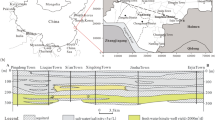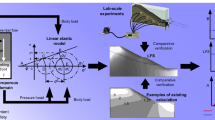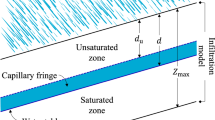Abstract
Hydraulic and mechanical parameters are very important in the calculation of models of land subsidence and ground fissures caused by groundwater exploitation. To investigate the degree of influence of these parameters on calculation of models of land subsidence and ground fissures, Morris’ global sensitivity analysis, combined with local sensitivity analysis, was applied. The accuracy of soil parameter sensitivity analysis is related closely to selection of the calculation model used. Based on Biot’s consolidation theory, and combined with the nonlinear rheological theory of soil, a three-dimensional full coupling mathematic model was established to simulate land subsidence and ground fissures, in which the constitutive relation in Biot’s consolidation theory was extended to viscoelastic plasticity. The dynamic relationships of soil parameters (porosity, permeability coefficient, parameters of soil deformation) accompanied by changes in the stress field were also considered. Consequently, this model conforms to actual conditions in the field. Nantong, Jiangsu Province in China, was selected to simulate and calculate land subsidence and ground fissures using this model, and the soil parameters’ sensitivities were analyzed. The results showed that elastic modulus, E, cohesion, c, and the specific weight of soil, \( \lambda \), have a significant influence on land subsidence and ground fissures, with the influence of the friction angle, \( \varphi \), on land subsidence, and of Poisson’s ratio, \( \nu\), on ground fissures taking second place. These five parameters are thus of major concern in the simulation of land subsidence and ground fissures.
















Similar content being viewed by others
References
Asadi R, Ataie-Ashtiani B, Simmons CT (2014) Finite volume coupling strategies for the solution of a Biot consolidation model. Comput Geotech 55(1):494–505
Bankher KA, Al-Harthi AA (1999) Earth fissuring and land subsidence in western Saudi Arabia. Nat Hazards 20:21–42
Braddock RD, Schreider Sy (2006) Application of the Morris algorithm for sensitivity analysis of the REALM model for the Goulburn irrigation system. Environ Model Assess 11:297–313
Chen CX, Pei SP (2001) Research on groundwater exploitation land subsidence model. Hydrogeol Eng Geol 28(2):5–8
Dassargues A, Zhang J (1992) Land subsidence in Shanghai: hydrogeological conditions and subsidence measurements. Bull Eng Geol Environ 46(1):27–36
Ferronato M, Castelletto N, Gambolati G (2010) A fully coupled 3-D mixed finite element model of Biot consolidation. J Comput Phys 229:4813–4830
Gong SL (1998) Effects of urban construction on land subsidence in Shanghai (in Chinese). Chin J Geol Hazard Control 9(2):108–111
King DM, Perera BJC (2013) Morris method of sensitivity analysis applied to assess the importance of input variables on urban water supply yield—a case study. J Hydrol 477(1):17–32
Li YM, Zhou FY (2004) Solution to a class of boundary value problem of three dimensional partial differential equation. J Jiangsu Univ Nat Sci J Earth Sci Environ Ed 25(4):328–331
Luo ZJ, Zeng F (2011) Finite element numerical simulation of land subsidence and groundwater exploitation based on visco-elastic–plastic Biot’s consolidation theory. J Hydrodyn 23(5):615–624
Luo G, Zhang J (2004) Improvement of Duncan-Chang nonlinear model and Shen Zhujiang’s elastoplastic model for granular soils. Rock Soil Mech 25(6):887–890
Luo ZJ, Liu JB, Li L (2008) Three-dimensional full coupling numerical simulation of groundwater dewatering and land-subsidence in Quaternary loose sediments. Chin J Geotech Eng 30(2):193–198
Meng XM, Tian FQ (2011) Sensitivity analysis of model parameters for confined aquifer specific vulnerability assessment in leakage area. J Hydroelectr Eng 30(4):49–55
Morris MD (1991) Factorial sampling plans for preliminary computational experiments. Technometrics 33:161–174
Peng GL (2005) Fortan 95. China Electric Power Press, Beijing
Qian JH, Yin ZZ (1996) Principle and canculation of geotechnics. China Waterpower Press, Beijing
Ran QQ, Li SL (1997) Study on dynamic models of reservoir parameters in the coupled simulation of multiphase flow and reservoir deformation. Pet Explor Dev 24(3):61–65
Sayyaf M, Mahdavi M, Barani OR, Feiznia S, Motamedvaziri B (2014) Simulation of land subsidence using finite element method: Rafsanjan plain case study. Nat Hazards 72:309–322
Serva L, Brunamonte F (2007) Subsidence in the Pontina Plain, Italy. Bull Eng Geol Environ 66(2):125–134
Shu LC, Wang MM, Liu RG, Chen GH (2007) Sensitivity analysis of parameters in numerical simulation of groundwater. J Hohai Univ Nat Sci 35(5):491–495
Smith IM, Griffiths DV (2003) Programming the finite element method, 3rd edn. (trans: Song W, Jianxin W, Lai W) Electronic Industry Press, Beijing
Song XM, Kong FZ, Zhan CS, Han JW, Zhang XH (2013) Parameter identification and global sensitivity analysis of Xin’anjiang model using meta-modeling approach. Water Sci Eng 6(1):1–17
Sun YW, Wei XM, Pomeroy CA (2011) Global analysis of sensitivity of bioretention cell design elements to hydrologic performance. Water Sci Eng 4(3):246–257
Tian J, Liu XG, Shang GH (2005) Casing damage mechanism based on theory of fluid-solid coupling flow through underground rock. J Hydrodyn A20(2):221–225
Xu CG, Hu YM, Chang Y, Jiang Y, Li XZ, Bu RC, He HS (2004) Sensitivity analysis in ecological modeling. Chin J Appl Ecol 15(6):1056–1062
Xu YS, Shen SL, Cai ZY, Zhou GY (2008) The state of land subsidence and prediction approaches due to groundwater withdrawal in China. Nat Hazards 45:123–135
Acknowledgments
This research was supported by the Jiangsu Grand Special Fund (dk2014ky-02).
Author information
Authors and Affiliations
Corresponding author
Rights and permissions
About this article
Cite this article
Jin, Wz., Luo, Zj. & Wu, Xh. Sensitivity analysis of related parameters in simulation of land subsidence and ground fissures caused by groundwater exploitation. Bull Eng Geol Environ 75, 1143–1156 (2016). https://doi.org/10.1007/s10064-016-0897-z
Received:
Accepted:
Published:
Issue Date:
DOI: https://doi.org/10.1007/s10064-016-0897-z




